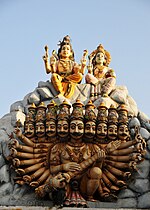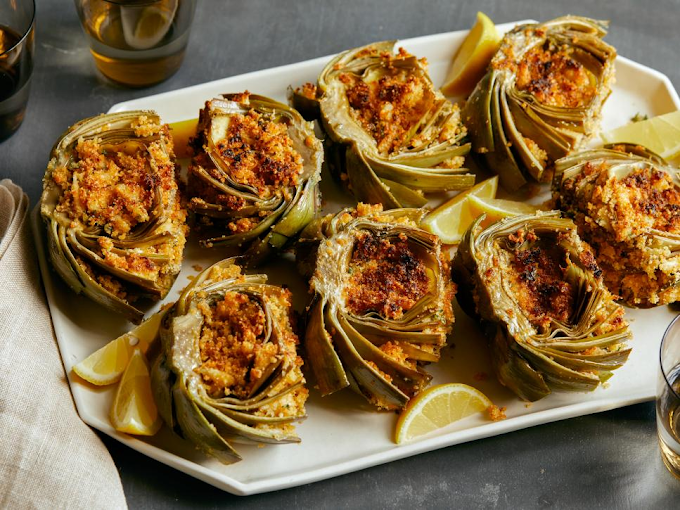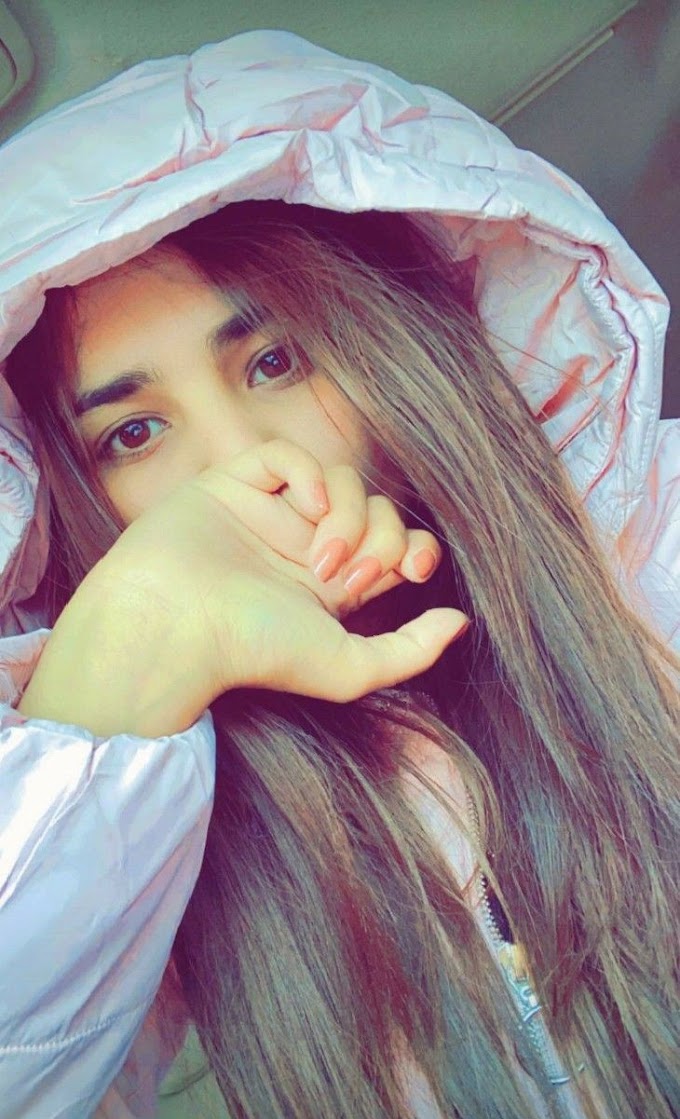Ravana
Several terms redirect here. For other uses, see Ravan (disambiguation).
Ravana (/ˈrɑːvənə/;[1] Sanskrit: रावण, IAST: Rāvaṇa, pronounced [ˈraːʋɐɳɐ]) is a rakshasa king[2] of the island of Lanka, and the chief antagonist of the Hindu epic Ramayana and its adaptations.[3][4] In the Ramayana, Ravana is described to be the eldest son of sage Vishrava and rakshasi Kaikesi. He abducted Prince Rama's wife Sita and took her to his kingdom of Lanka, where he held her in the Ashoka Vatika.[5] Later, Rama, with the support of vanara King Sugriva and his army of vanaras, launched an invasion against Ravana in Lanka. Ravana was subsequently slain and Rama rescued his beloved wife Sita.[6][7]
Ravana is widely portrayed to be an evil character, though he also has many qualities that make him a learned scholar. He was well-versed in the six shastras and the four Vedas.[citation needed] Ravana is also considered to be the most revered devotee of Shiva. Images of Ravana are seen associated with Shiva at some temples. He also appears in the Buddhist Mahayana text Laṅkāvatāra Sūtra, in Buddhist Ramayanas and Jatakas, as well as in Jain Ramayanas. In some scriptures, he is depicted as one of Vishnu's cursed doorkeepers.[8]
Etymology[edit]
The word Rāvaṇa (Sanskrit: रावण) means "roaring" (active), the opposite of Vaiśravaṇa, meaning "hear distinctly" (passive).[9][10] Both Ravana and Vaiśravaṇa, who are popularly known as Kubera, are considered to be patronymics derived from "sons of Vishrava".[9][10][11][12]
Rāvana was a title taken on later by Dashānana, and it means "the one with ten(Dasha) faces(anana)". Further, Ravana is Sanskrit for "loud roaring." In Abhinava Gupta's Krama Shaiva scripture, yāsām rāvanam is used as an expression to mean people who are truly aware in terms of the materialism of their environment.[citation needed]
Ravana has many other popular names, such as Davis Ravana, Dasis Sakvithi Maha Ravana, Dashaanan, Ravula, Lankapati, Lankeshwar, Lankeshwaran, Ravanasura, Ravanaeshwaran, and Eela Vendhar.[13]
Iconography[edit]
Ravana is depicted and described as having ten heads, although sometimes he is shown with only nine heads, as he cut one off to convince Shiva.[14] He is described as a devout follower of Shiva, a great scholar, a capable ruler and a maestro of the Veena (pronounced veh-nah; a chordophone instrument). Ravana is also depicted as the author of the Ravana Samhita, a book on Hindu astrology, and the Arka Prakasham, a book on Siddha medicine and treatment. Ravana possessed a thorough knowledge of Siddha and political science. He is said to have possessed the nectar of immortality, which was stored inside his belly, thanks to a celestial boon by Brahma.[15][page needed]
Life and legends[edit]
Birth[edit]
Ravana was born to the great sage Vishrava, and his wife, the Rakshasa princess Kaikesi in the Treta Yuga. People of Bisrakh village in Uttar Pradesh claim that Bisrakh was named after Vishrava and that Ravana was born there.[16] But according to Hela's historical sources and folklore, Ravana was born in Lanka, where he later became king.[17]
Ravana's grandfather on his father's side, the sage Pulastya,[18] was one of the ten Prajapatis or mind-born sons of Brahma and one of the Saptarishi (Seven Great Sages Rishi) in the first Manvantara (age of Manu). His maternal grandfather was Sumali (or Sumalaya); the king of the Rakshasas and the son of Sukesha. Sumali had ten sons and four daughters. Sumali wished Kaikeshi to marry the most powerful being in the mortal world, so as to produce an exceptional heir. He rejected the kings of the world, as they were less powerful than he. Kaikesi searched among the sages and finally chose Vishrava, the father of Kubera. Ravana and his siblings were born to the couple. They completed their education from their father, with Ravana being a great scholar of the Vedas.[citation needed]
Boon of Ravana[edit]
Ravana and his two brothers Kumbhakarna and Vibhishana performed penances on Mt Gokarna for 11,000 years and won boons from Brahma. Ravana was blessed with a boon that would make him invincible to all the creations of Brahma, except for humans.[19] He also received weapons, a chariot as well as the ability to shapeshift from Brahma. Ravana later usurped Lanka from his half-brother Kubera and became the King of Lanka. He appointed Shukracharya as his priest and learned the Arthashastra (Science of Politics) from him.[citation needed]
Devotee of Shiva[edit]
One of the most popular images of Shiva is called "Ravananugraha", which was popular in the Gupta era and depicts Ravana beneath Mount Kailash playing the veena made out of his head and hand with strings made out of his tendons while Shiva and Parvati sit on top of the mountain.[20][full citation needed] According to scriptures, Ravana once tried to lift Mount Kailash, but Shiva pushed the mountain into place and trapped Ravana beneath it. For a thousand years, the imprisoned Ravana sang hymns (Shiva Tandava Stotra) in praise of Shiva, who finally blessed him and granted him an invincible sword and a powerful linga (Shiva's iconic symbol, Atmalinga) to worship.[21][20]
Family[edit]
Ravana's family is hardly mentioned outside the Ramayana, which is viewed by some as being only the point of view of Rama devotees. According to that:
- Ravana's granduncle was Malyavan, who was against the war with Rama and Lakshmana. He also had another granduncle named Mali who was killed by Lord Vishnu.[22]
- Ravana's parents were sage Vishrava (son of Pulastya) and Kaikesi (daughter of Sumali and Tataka or Ketumati). Kaikesi had ten brothers, the famous generals in Lanka's army being Dhumraksha, Prahastha, and Akampana, and also Maricha and Subahu which would effectively make them Ravana's uncles and three aunts named Kumbinashi, Puspotkata, and Raka. Kaikesi's father, Sumali, was instrumental in making Ravana the king of Lanka by advising him to get boons from Brahma, defeat Kubera, and establish the Rakshasa rule in the three worlds.[22]
- Ravana had seven brothers and two sisters:[citation needed]
- Kubera – The King of the North direction and the Guardian of Heavenly Wealth. He was an older half-brother of Ravana. Kubera was born to Vishrava's other wife, Ilavida.
- Kumbhakarna – One of the most jovial demons in Hindu mythology. When offered a boon by Brahma, he was tricked into asking for eternal sleep. A horrified Ravana, out of brotherly love, persuaded Brahma to amend the boon. Brahma mitigated the power of the boon by making Kumbhakarna sleep for six months and being awake for the rest six months of the year (in some versions, he is awake for one day out of the year). During the war with Rama, Kumbhakarna was untimely awakened from his sleep. He tried to persuade Ravana to open negotiations with Rama and return Sita to him. But he too failed to mend the ways of Ravana. However, bound by a brother's duty, he fought on the side of Ravana and was killed on the battlefield. Before dying he met Vibhishana and blessed him for following the path of righteousness.
- Vibhishana – A follower of Rama and one of the most important characters in the Ramayana. As a minister and brother of Ravana, he spoke the truth without fear and advised Ravana to return the kidnapped Sita and uphold Dharma. Ravana not only rejected this sane advice but also banished him from his kingdom. Vibhishana sought protection from Rama, which was granted without hesitation.
- Khara – King of Jonathan.[23] He was a cousin of Ravana and the son of Kaikesi's sister Raka.
- Dushane – Viceroy of Jonathan. Cousin of Ravana and twin brother of Khara.
- Ahiravan – In Krittivasi Ramayan, Ahiravan was king of the Underworld ruled by the rakshasas by Ravana and the demon king Maya.
- Kumbhini – The older half-sister of Ravana and the wife of the demon Madhu, King of Mathura. She was the mother of Lavanasura.
- Sahastra Ravana - He is mentioned in Adbhuta Ramayana as the elder brother of Ravana, two thousand armed and thousand-headed, living on an island named Pushkar, he was originally much more powerful than his younger brother. However, Ten-headed Ravana was still the main enemy of the Gods since Ten-Headed Ravana had Brahma’s boon. Sahastra Ravana is slain by Sita who takes the form of Mahakali to slay him.[24]
- Shurpanakha – The sister of Ravana. She was the ultimate root of the kidnapping of Sita. She was the one who instigated her brothers to wage a war against Rama.
- Ravana was married to Mandodari, the daughter of the celestial architect Maya, Dhanyamalini, and a third wife. His sons from his three wives were as follows:[citation needed]
- Meghna (also known as Indrajit because he defeated Indra), was the most powerful son of Ravana. He was born to Ravana's elder consort Mandodari.
- Atikaya
- Akshayakumara
- Narantaka
- Devantaka
- Trishira
- Prahasta
- In the Bengali ballad "Meghnad Bodh Kavya" by Michael Madhusudan Dutt, Beerbahu is said to be Ravana's son.[citation needed]
Priestly ministers[edit]
Ravana is said in some versions to have had Shukracharya, the priest of the Asuras, as his minister, and in some versions Brihaspati, the priest of the Devas.[citation needed]
One of the most original, which is not found in earlier manuscripts, tells how Ravana orders his court priest Brhaspati (all the gods being his slaves) to read the Chandi stava (mantras of Chandi), that is, the Devi Mahatmya, in order to stave off defeat if he can recite it. According to the Krttivasa text, Ravana arranged for a peaceful yajna (sacrifice), and to start the recitation of Chandi, Brihaspati was invited. Accordingly, Brihaspati recited the same correctly.[25][full citation needed]
Other legends[edit]
As Vishnu's cursed doorkeeper[edit]
In the Bhagavata Purana, Ravana and his brother, Kumbhakarna, were said to be reincarnations of Jaya and Vijaya, gatekeepers at Vaikuntha (the abode of Vishnu) and were cursed to be born on Earth for their insolence.[27]
These gatekeepers refused entry to the Samantha Kumara monks — who, because of their powers and austerity, appeared as young children. For their insolence, the monks cursed them to be expelled from Vaikuntha and to be born on Earth.[citation needed]
Vishnu agreed that they should be punished. They were given two choices, they could be born seven times as normal mortals and devotees of Vishnu, or three times as powerful and strong people, but as enemies of Vishnu. Eager to be back with the Lord, they choose the latter one. Ravana and his brother Kumbhakarna were born to fulfill the curse on the second birth as enemies of Vishnu in the Treta Yuga. The curse of first birth was fulfilled by Hiranyakashipu and his brother Hiranyaksha in Satya Yuga when they were both vanquished by earlier avatars of Vishnu (Hiranyaksha by Varaha and Hiranyakashipu by Narasimha) and the curse of third birth was fulfilled by Dantavakra and Shishupala in the Dvapara Yuga when they both were slain by Krishna, the eighth avatar.[8]
Conflict with other kings and Asuras[edit]
Ravana had gotten into a conflict with some other major Asuras.[citation needed]
- In Maheshwar, Madhya Pradesh is where he is said to have fought, but lost, to Kartavirya Arjuna, and he was tied up; later Kartavirya got the name Daśagrivajayi (the conqueror of Ravana just like Indrajit got his name by defeating Indra) and released him on the request of his grandfather sage Pulastya. Ravana vanquished.
- Marutta (Chakravarti King of Ushiraviga),
- Gadhi (Vishwamitra's father),
- Dushyanta (Bharata's father),
- Suratha (King of Vidarbha),
- Gaya (Chakravarti king of Dharmaranya), and
- Paurava (King of Anga).
- Ravana killed Anaranya, the king of Ayodhya although the latter cursed Ravana to be slain by Rama.
- Ravana was vanquished by the Ikshvaku King Mandhata, an ancestor of Rama.
- Ravana had wrestled his brother Kubera for the Pushpaka Vimana.
- In the Ramayana, he fought Vali the Kishkindha king but was defeated by him, because of Vali's boon to obtain half the strength of anyone he fought.[28]
- He also fought with the Nivatakavachas, the descendants of Prahlada, but being unable to defeat them, struck an alliance with them.
- Another time he was vanquished by the sage Kapila.
- One time, upon hearing a discourse from Sage Sanatkumara, Ravana attempted to invade Vaikuntha. Only Ravana managed to enter Vaikuntha's capital Shwetadwipa where he was hopelessly outmatched by the inhabitants over there and was forced to retreat.
Worship and temples[edit]
Worship[edit]
As he is considered one of the most revered devotees of Shiva, Ravana is worshiped in several places.[29] There are some Shiva temples where Ravana is worshiped.[29][30][31]
The Kanyakubja Brahmins of the Vidisha district worship Ravana; they personify him as a symbol of prosperity and regard him as a savior, claiming that Ravana was also a Kanyakubja Brahmin. Thousands of Kanyakubja Brahmins of the village Ravangram of Netaran, in the Vidisha District of Madhya Pradesh, perform daily puja (worship) in the Ravana temple and offer naivedyam / blog (a ritual of sacrifice to the Gods). Centuries ago King Shiv Shankar built a Ravana temple at Kanpur, Uttar Pradesh. The Ravana temple is opened once a year, on Dashehra Day, to perform puja for the welfare of Ravana.[32]
Ravana is also worshiped by Hindus of Bisrakh, who claim their town to be his birthplace.[33]
The Sachora Brahmins of Gujarat also claim to be descendants of Ravana and sometimes have "Ravan" as their surname.[34]
Some Saraswat Brahmins from Mathura claim Ravana as a Saraswat Brahmin as per his lineage.[35][36]
There is also a reference to "Ravani", the lineage of Upadhyaya Yasastrata II, who was of the Gautama gotra and was a son of Acharya Vasudatta, and described as "born of Ravani".[37][full citation needed]
The Gondi people of central India claim to be descendants of Ravana, and they have temples set up for him, his wife Mandodari, and their son Meghnad. They also state that Ravana was an ancient Gond king, the tenth dharma guru of their tribe, and the eighteenth lingo (divine teacher). Every year on Dussehra, the Gondi's of the village of Paraswadi carry an image of Ravana riding on an elephant in a procession[38]
Temples[edit]
There are a number of temples in India for Ravana as a Shaiva bhakt,
- Dashan Temple, Kanpur, Uttar Pradesh[39]
- Ravana Mandir, Bisrakh, Greater Noida, Uttar Pradesh[39]
- Kakinada Ravana temple, Andhra Pradesh[39]
- Ravangram Ravana Temple, Vidisha, Madhya Pradesh[39]
- Mandsaur, Madhya Pradesh[39]
- Mandore Ravan Temple, Jodhpur[40]
- Baijanath Temple, Kangra district, Himachal Pradesh[40]
Influence on culture and art[edit]
A Ramleela actor wears the traditional attire of Ravana. One of the most important literary works of ancient India, the Ramayana has had a profound impact on art and culture in the Indian subcontinent and Southeast Asia.[41]
Ravana-Dahan (a burning effigy of Ravana)[edit]
Effigies of Ravana are burned on Vijayadashami in many places throughout India. It is said that this symbolizes Rama's triumph over evil (i.e., Ravana).[42]
Ravanahatha[edit]
The ravanahatha, an ancient bowed-string instrument, continues to be used as a Rajasthani folk instrument. Mythology credits this instrument as a creation of Ravana.[43]
In other religions[edit]
In Rin-spins-pa Tibetan Ramayana, it is prophesied that "Ravana" will return as the Buddha incarnation of Vishnu in the Kali Yuga.
The Tai Khamti Ramayana (Phra Chow Lamang) of Arunachal Pradesh as well describes Rama as a Bodhisattva incarnated to get tortured by Ravana.
In the Laotian Buddhist text Phra Lak Phra Lam, Rama is a Bodhisattva and the embodiment of virtues, while Ravana is a Brahmin ("mahabrahma") son of Virulaha who is highly materialistic.[citation needed]
In the Cambodian Buddhist text Preah Ream, Buddha is an incarnation of Rama and Ravana. He is a rakshasa.[citation needed]
In the Thai Buddhist text Ramakien, Rāvana is a rakshasa.[44] There, he is instead known as "Thotsakan" (ทศกัณฐ์, from Sanskrit दशकण्ठ, Daśakaṇṭha, "ten necks"), and he is depicted with green skin.[citation needed]
In the Lankavatara Sutra, Gautama Buddha pays a visit to Lanka, and in the scripture, he is addressed as a Rakshasa. He is normally identified as a demon.
In the Karandavyuha Sutra, the god Yama asks if the visitor in hell (Avalokitesvara) whom he hasn't seen yet is a god or a demon, and asks whether he is Vishnu, Mahesvara, or the rakshasa ("demon") Ravana.
Jain version[edit]
Jain accounts vary from the traditional Hindu accounts of Ramayana. The incidents are placed at the time of the 20th Tirthankara, Munisuvrata. According to the Jain version, both Rama as well as Ravana were devout Jains.[45] Ravana was a Vidyadhara King who had magical powers.[46] Also, as per the Jain accounts, Ravana was killed by Lakshmana and not Rama in the end.[47]
Dravidian movement[edit]
Pulavar Kuzhanthai's Ravana Kaaviyam, is a panegyric on Ravana. The book is made of 3100 poetic stanzas in which Ravana is the hero. The book was released in 1946. The book was banned by the then Congress state government. The ban was lifted only in 1971.[48][49][50]
Download link

.png)









.jpg)




.jpg)






0 Comments